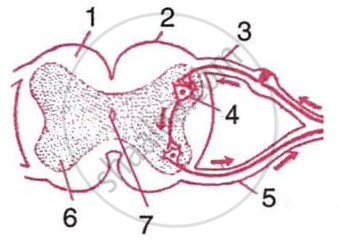Advertisements
Advertisements
प्रश्न
Given alongside is a partial diagrammatic representation of a certain phenomenon pertaining to the nervous system.
 |
- Name the parts numbered 1-7.
- Name the phenomenon that the diagram depicts and define it.
- Give the technical term for the point of contact between two nerve cells.
- Name the parts not shown in the diagram that should be included to complete the pathway of the phenomenon.
उत्तर
-
- White matter
- Spinal cord
- Dorsal root (sensory)
- Association Neuron
- Ventral root
- Gray matter
- Central Canal
- The diagram depicts spinal reflex action.
It is an automatic/quick/immediate, involuntary action in the body brought about by a stimulus. - Synapse
- Receptor, sensory neuron, motor neuron, ·spinal nerve, effector muscles
संबंधित प्रश्न
How are involuntary actions and reflex actions different from each other?
If we happen to touch a hot object unknowingly, we immediately pull back our hand. What is this type of action known as?
Which part of the eye contains cells which are sensitive to light?
What is meant by receptors and effectors? Give two examples of each.
Which of the following cannot be considered a receptor?
(a) ear
(b) nose
(c) muscle
(d) eye
Which of the following is not an involuntary action?
(a) vomiting
(b) chewing
(c) heart beat
(d) salivation
The gustatory receptors of our body are in one of the following organs. This organ is :
a) ear
(b) nose
(c) tongue
(d) skin
Give one example of a conditioned reflex in your own life.
State whether the following is
The sudden application of brakes without thinking
Give Technical Term:
The scientist, who conducted experiment on a dog to show conditioned reflex
